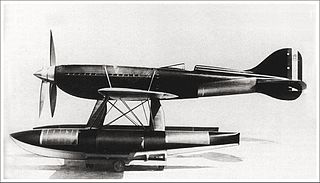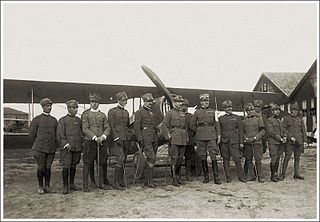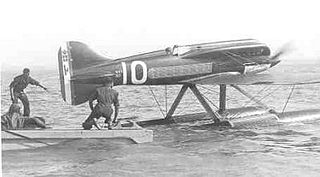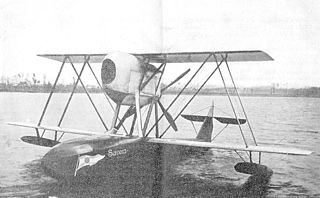| Macchi M.33 | |
|---|---|
 | |
| Role | Racing flying boat |
| Manufacturer | Aeronautica Macchi |
| First flight | 1925 |
| Primary user | Italy |
| Number built | 2 |
The Macchi M.33 was an Italian racing flying boat which competed in the 1925 Schneider Trophy race.
| Macchi M.33 | |
|---|---|
 | |
| Role | Racing flying boat |
| Manufacturer | Aeronautica Macchi |
| First flight | 1925 |
| Primary user | Italy |
| Number built | 2 |
The Macchi M.33 was an Italian racing flying boat which competed in the 1925 Schneider Trophy race.
The Macchi M.33 was a single-seat, wooden, shoulder-wing monoplane flying boat of very clean aerodynamic design for its time. Its cantilever wing was fairly thick and carried stabilizing floats on each side. Italy lacked competitive racing engines in 1925, so the M.33 was powered with a used 1923 Curtiss D-12 engine rated at 378 kilowatts (507 horsepower) in a streamlined nacelle mounted on struts above the fuselage and driving a two-bladed tractor propeller. The M.33 had a flat-plate radiator, a type that was obsolescent by 1925, rather than modern surface radiators. [1]
The D-12 engines powering M.33s were worn-out and unreliable and lacked the power of newer foreign engines, and pilots reported that the aircraft suffered from wing flutter. [1]

Despite the M.33's shortcomings, Italy entered two of them in the 1925 Schneider Trophy race hosted by the United States at Baltimore, Maryland. The one piloted by Riccardo Morselli was scratched from the race because of engine ignition problems. Giovanni de Briganti piloted the other M.33; during the race he did not use full throttle out of fear for his aircraft's engine and wing problems, and was further delayed by a navigational error he made during the second lap of the seven-lap race. He came in third with an average speed of 271 kilometers per hour (168 miles per hour); this was well behind the second-place finisher, a British Gloster IIIA piloted by Hubert Broad which finished with an average speed of 321 kilometers per hour (199 miles per hour), and also behind the winner, an American Curtiss R3C-2 piloted by Jimmy Doolittle (1896-1993), which finished with an average speed of 374 kilometers per hour (233 miles per hour). [1]
De Briganti's M.33 was the last flying boat to compete in the Schneider Trophy races. [1]
Data from Vitesse à l'italienne: Le Macchi M.33 [2]
General characteristics
Performance
Related lists

The Coupe d'Aviation Maritime Jacques Schneider, also known as the Schneider Trophy, Schneider Prize or (incorrectly) the Schneider Cup is a trophy that was awarded annually to the winner of a race for seaplanes and flying boats. The Schneider Trophy is now held at the Science Museum, South Kensington, London.

The Macchi M.C. 72 is an experimental seaplane designed and built by the Italian aircraft company Macchi Aeronautica. The M.C. 72 held the world speed record for all aircraft for five years. In 1933 and 1934 it set world speed records for piston engine-powered seaplanes; the latter still stands.

The Macchi M.39 was a racing seaplane designed and built by the Italian aircraft company Aeronautica Macchi in 1925–26. An M.39 piloted by Major Mario de Bernardi (1893–1959) won the 1926 Schneider Trophy, and the type also set world speed records that year.

The Supermarine S.4 was a 1920s British single-engined monoplane built by Supermarine. Designed by a team led by the company's chief designer, R. J. Mitchell, it was built to race in the 1925 Schneider Trophy contest.

Mario de Bernardi (1893–1959) was an Italian World War I fighter pilot, seaplane air racer of the 1920s, and test pilot of early Italian experimental jets.

The Supermarine S.5 was a 1920s British single-engined single-seat racing seaplane built by Supermarine. Designed specifically for the Schneider Trophy competition, the S.5 was the progenitor of a line of racing aircraft that ultimately led to the Supermarine Spitfire.

The Curtiss R3C is an American racing aircraft built in landplane and floatplane form. It was a single-seat biplane built by the Curtiss Aeroplane and Motor Company.

The Curtiss CR was a racing aircraft designed for the United States Navy in 1921 by Curtiss. It was a conventional single-seater biplane with a monocoque fuselage and staggered single-bay wings of equal span braced with N-struts. Two essentially similar landplane versions were built as the CR-1 and CR-2, which were both eventually converted to seaplanes as the CR-3 in 1923 and CR-4 in 1924. A refined version was developed for the US Army Air Service under the designation R-6. These latter two aircraft featured refined aerodynamics included surface-mounted radiators.

The Curtiss R2C was a racing aircraft designed for the United States Navy in 1923 by Curtiss. It was a single-seater biplane with a monocoque fuselage and staggered single-bay wings of unequal span braced with I-struts. The aircraft's advanced streamlining featured a top wing mounted directly to the top of the fuselage and surface-mounted radiators for cooling the engine. The aircraft was originally designed and built as a landplane under the Navy designation R2C-1, of which two examples were produced. One was converted into a seaplane version known as the R2C-2 the following year.

The Supermarine Sea Lion II was a British racing flying boat built by the Supermarine Aviation Works. Designed by Reginald Mitchell, it was a modification of Supermarine's Sea King II. Sea Lion II was powered by a 450 hp (340 kW) Napier Lion engine.

The Gloster III was a British racing floatplane of the 1920s intended to compete for the Schneider Trophy air race. A single-engined, single-seat biplane, two were built, with one finishing second in the 1925 race.

The Macchi M.5 was an Italian single-seat fighter flying boat designed and built by Nieuport-Macchi at Varese. It was extremely manoeuvrable and agile and matched the land-based aircraft it had to fight.

The Macchi M.7 was an Italian single-seat fighter flying boat designed by Alessandro Tonini and built by Macchi. A modified version of the M.7, the M.7bis won the Schneider Trophy in 1921.

The Macchi M.52 was an Italian racing seaplane designed and built by Macchi for the 1927 Schneider Trophy race. The M.52 and a later variant, the M.52bis or M.52R, both set world speed records for seaplanes.
The Gloster II was a British racing floatplane of the 1920s. A single-engined biplane, two were built to compete in the 1924 Schneider Trophy air race. However the crash of the first prototype during testing meant that it could not be made ready for the race, which was postponed. The second aircraft was also lost in a crash.

The Gloster IV was a British racing floatplane of the 1920s. A single-engined biplane, the Gloster IV was a development of the earlier Gloster III intended to compete in the 1927 Schneider Trophy race. One aircraft competed in the race, but retired part way through. The three aircraft built continued to be used as trainers by the High Speed Flight for several years.

The Macchi M.67, was an Italian racing seaplane designed by Mario Castoldi and built by Macchi for the 1929 Schneider Trophy race.

The SIAI S.21 was an Italian racing flying boat built by SIAI for the 1921 Schneider Trophy race.

The Macchi M.17 was an Italian racing flying boat built by Macchi for the 1922 Schneider Trophy race.
Giovanni De Briganti was an Italian World War I fighter pilot, seaplane air racer of the 1920s, aerobatic pilot, and test pilot.